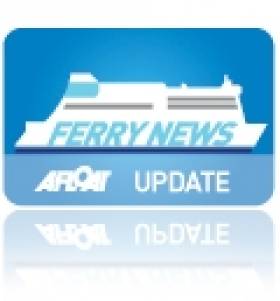Displaying items by tag: B&I Line
Former Irish Sea Freight Ferries Scrapped in Turkey
#FerryBreakers – In 2011, Afloat.ie reported on a trio of Irish Sea Larne-Fleetwood (since closed) ro-ro freight vessels which Stena Line sold to Russian interests in the Black Sea and understood for use in the recently held Winter Olympics in Sochi, writes Jehan Ashmore.
The sisters Stena Seafarer, Stena Leader and Stena Pioneer, the latter which as Bison between 1989-1993 served B&I Line on joint service with P&O's freight division, Pandoro between Dublin-Liverpool.
At the time of the vessels sale, they departed Belfast Lough in mid-June. They were understood to be bound for to Sevastopol in the Ukraine and placed under the Moldovan flag and with a port of registry in Giurgiulesti.
For much more on this story, Ships Monthly reports of the German-built sisters which spent more than 30 years on Irish Sea freight services originally for P&O before their most recent spells with Russian operator Antship. They fittingly ended their days together after arriving at Aliaga, Turkey for scrapping during February.
The Timber Traders and Days of Old Irish Sea Shipping Companies
#PORTS & SHIPPING- The general dry-cargo vessel, Red Duchess berthed at Ardrishaig on Scotland's west coast at Loch Fyne today, after completion of a voyage from Waterford, writes Jehan Ashmore.
The 1969-built coaster rounded the Hook Head Lighthouse yesterday around noon, having departed Belview on Waterford Estuary. She is engaged on the Irish Sea timber trade, which have been the mainstay of the cruiser stern-vessel's career (see PHOTO).This feature maybe commonplace among yachting craft, yet it is an increasing rare feature, to be found on commercial ships these days.
Her builders were Bodewes Hoogezand Scheepswerf, Bergum of The Netherlands, though the veteran vessel received a modernisation programme in 1995. In addition to the 1,285grt Red Duchess, her fleetmate Red Baroness (1979/964grt) is also actively employed on the same trade.
Each vessel has a single 80m box-hold which can also handle coal, fertiliser, salt and stone. The UK flagged vessels are owned and managed by Coast Lines Shipping based in Midleton, Co. Cork which was established in 1981. For photos of the fleet and technical details, click HERE.
The name of the Irish shipping company revives the similarly named Coast Lines which was synonymous with the British & Irish Steam Packet Co. Ltd otherwise known as B+I Line. By 1917 the Coast Lines group operated seven Irish shipping companies and held all the shares in B+I Line.
The group also had a half interest in David MacBrayne, which was together acquired in the same year by Lord Kylsant's Royal Mail Steam Packet. It was during the Kylsant period that one of their vessels, the 696 ton Lochfyne served David MacBrayne. The Kylsant shipping empire collapsed and Coast Lines regained independence in 1935.
It is apt to have these historical associations as successors to David MacBrayne, now Caledonian MacBrayne (CalMac) are Scotland's largest island ferry network which includes the Loch Fyne ferry (PHOTO) route of Portavadie-Tarbert with the remote location of Ardrishaig further up the Loch.
By 1965 Coast Lines sold their British & Irish (including the associated City of Cork Co.) to the Irish Government and the remaining part of the company was purchased by P&O in 1971. This marked an end of era, with the names of several Irish Sea freight and ferry operators slipping away.
As for Coast Lines Shipping, which was established in 1981, both Red Duchess and Red Baroness are on a time charter arrangement with JST Services. The Ayr-based company provide an integrated shipping, handling and road haulage timber business in addition to the carriage of other cargoes.
Asides serving Ardrishaig, the red-hulled vessels call to their adopted homeport of Ayr, Campbeltown and Sandbank. In addition they call to Troon, where both coasters are registered (see PHOTO). From these ports they sail to Irish ports, in particular Derry, Youghal and Passage West, a privately-owned wharf in the centre of Cork Harbour.
Timber products can include logs, which are loaded by a grabber as depicted in this PHOTO taken at Passage West. The facility also deals in scrap-metal cargo, where a mounting pile is clearly evident on the quayside, awaiting to be disposed for export.
- Shipping
- Irish ports
- irish sea
- Red Duchess
- Coast Lines
- Hook Head Lighthouse
- Caledonian MacBrayne
- B&I Line
- Ports & Shipping news
- timber
- British & Irish Steam Packet Co
- Coast Lines Group
- Coast Lines Shipping Ltd
- JST Services
- Belview Waterford
- Red Baroness
- Irish Sea shortsea coasters
- Irish Sea fshipping companies
- CalMac
- Royal Mail Steam Packet
- Irish Sea coasters
- Irish Sea short sea shipping
- Loch Fyne Scotland
- David MacBrayne
- Passage West Cork Harbour
- Cork Harbour
- PortavadieTarbert
- MV Isle of Cumbrae
National Commemoration Services for Irish Seafarers
#EVENTS-The annual Seafarers Commemoration in Cork will be held at 12 noon, on 28th November in the Port of Cork Offices, Custom House Quay.
The event is organised by the Cork branch of the Maritime Institute of Ireland which also hosted the Seafarers Commemoration in Dublin last Sunday where a mass was held at City Quay Church. Wreaths were laid afterwards at the nearby Irish Seaman's National Memorial, for the men of the Irish mercantile marine who lost their lives at sea during the Second World War.
In the afternoon, a commemoration service of those who lost their lives on Irish ships also took place at Evensong in St. Patricks Cathedral.
As the 'family of the sea' gathered at the City Quay memorial, this provided an opportunity to reflect memories of former seafarers. In recent years, the memorial service has been extended to honour all Irish seafarers who have died at sea.
For further information detailing lists of Irish merchant ships lost during WW2 and the names of those seamen lost, click HERE in addition a short video clip depicting war footage and paintings of Irish vessels lost.
Yesterday marked the 20th anniversary of the sinking of the B&I Line containership Kilkenny in Dublin Bay in which three crew lost their lives in a collision with the German owned Lo/Lo Hasselwerder.
A memorial to the incident in 1991 is located at Irish Continental Group's (ICG) headquarters in Dublin Port, where the former state-run B&I Line was based before privatisation and sold to ICG's ferry subsidiary Irish Ferries.
































































